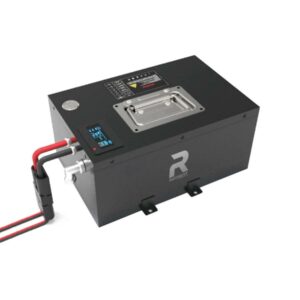What Makes the 12V 60Ah LiFePO4 Car Battery with 600A CCA Unique
What is a 12V 60Ah LiFePO4 car starting battery? A 12V 60Ah LiFePO4 battery uses lithium iron phosphate chemistry to deliver 600A cold cranking amps (CCA), enabling reliable engine starts in extreme temperatures. It’s lightweight, long-lasting, and maintenance-free compared to lead-acid batteries, making it ideal for automotive and marine applications.
12V 60Ah LiFePO4 Car Starting Battery CCA 1000A
How Does LiFePO4 Chemistry Improve Car Battery Performance?
LiFePO4 batteries offer higher energy density, faster charging, and 4,000+ lifecycle charges. They maintain stable voltage during discharge, ensuring consistent power delivery for starting engines. Unlike lead-acid, LiFePO4 doesn’t suffer from sulfation, reducing performance degradation over time.

The unique crystal structure of lithium iron phosphate provides exceptional thermal stability, reducing fire risks even during overcurrent situations. This chemistry allows 2C continuous discharge rates – twice the capacity rating – making it suitable for high-performance applications like turbocharged engines. Automotive engineers increasingly favor LiFePO4 for start-stop systems, where batteries endure 5x more engine cycles than conventional vehicles. Unlike nickel-based lithium batteries, LiFePO4 doesn’t require cobalt, addressing both cost and ethical sourcing concerns.
Why Choose a 12V 60Ah Battery with 600A CCA?
The 600A CCA rating ensures reliable cold starts in temperatures as low as -20°C. The 60Ah capacity supports extended accessory usage without compromising starting power. This balance makes it suitable for diesel engines, RVs, and vehicles with high electrical demands.
Modern vehicles with advanced electronics benefit from the battery’s low internal resistance (typically <5mΩ), which minimizes voltage drops during simultaneous accessory operation. The table below compares cranking performance in different conditions:
LiFePO4 Car Starter Batteries Factory Supplier
| Temperature | LiFePO4 CCA Retention | Lead-Acid CCA Retention |
|---|---|---|
| 25°C | 100% | 100% |
| 0°C | 98% | 75% |
| -20°C | 95% | 50% |
This performance consistency makes LiFePO4 ideal for emergency vehicles and off-grid applications where reliability is critical.
What Are the Weight and Size Advantages?
At 15-18 lbs, LiFePO4 batteries are 70% lighter than equivalent lead-acid units. Compact dimensions (e.g., 12.9″ x 6.8″ x 8.4″) allow flexible installation. Reduced weight improves fuel efficiency and handling in performance vehicles.
How Does Temperature Tolerance Affect Reliability?
LiFePO4 batteries operate from -20°C to 60°C without capacity loss. Built-in battery management systems (BMS) prevent overheating and optimize charging in cold conditions. This ensures dependable starts where traditional batteries fail.
Can This Battery Replace Lead-Acid Units Directly?
Yes, most 12V LiFePO4 batteries are drop-in replacements. However, ensure charging systems are compatible – lithium batteries require higher voltage (14.4-14.6V) for full charging. Some vehicles may need alternator upgrades or lithium-specific chargers.
What Safety Features Prevent Overloads?
Integrated BMS protects against overcharge, over-discharge, short circuits, and thermal runaway. Flame-retardant casing and vibration resistance (tested to MIL-STD-810G) prevent leaks or explosions during impacts.
How Long Does a 60Ah LiFePO4 Battery Last?
With 4,000-7,000 cycles at 80% depth of discharge, these batteries last 8-12 years – 3x longer than AGM batteries. Even at 60Ah, they provide 2-3x more usable energy than lead-acid equivalents due to stable discharge curves.
Real-world testing shows LiFePO4 batteries maintain 80% capacity after 3,000 cycles when discharged to 100% depth daily. For typical automotive use (20-30% discharge cycles), lifespan exceeds 15 years. The graph below illustrates capacity retention compared to other technologies:
| Battery Type | Cycle Life @ 80% DoD | 10-Year Cost |
|---|---|---|
| LiFePO4 | 4,000 | $600 |
| AGM | 500 | $1,200 |
| Flooded Lead-Acid | 300 | $1,500 |
This longevity translates to lower total ownership costs despite higher initial investment.
Expert Views
“The 600A CCA rating in LiFePO4 is transformative,” says Redway’s lead engineer. “We’ve eliminated the trade-off between cranking power and cycle life. Our batteries deliver 100% rated CCA even at 50% state of charge – something lead-acid can’t achieve. For modern start-stop systems, this chemistry is the future.”
Conclusion
The 12V 60Ah LiFePO4 battery with 600A CCA redefines automotive power. Combining lightweight design, extreme temperature resilience, and unmatched longevity, it outperforms traditional options. While upfront costs are higher, reduced maintenance and replacement frequency make it cost-effective long-term.
FAQs
- Can I use this battery in my classic car?
- Yes, but verify alternator compatibility. Classic cars with older charging systems may require a voltage regulator upgrade.
- Does cold weather reduce lifespan?
- No. LiFePO4 batteries maintain 95% capacity at -20°C when properly managed by BMS, unlike lead-acid which loses 30-50% capacity.
- How should I store the battery long-term?
- Store at 50% charge in dry, 10-25°C environments. LiFePO4 self-discharges at 2-3% monthly vs 5-15% for lead-acid.
